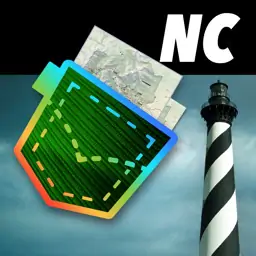BrochureCurrituck |
Brochure of Currituck National Wildlife Refuge (NWR) in North Carolina. Published by the U.S. Fish & Wildlife Service (USFWS).
featured in
| North Carolina Pocket Maps |  |
U.S. Fish & Wildlife Service
Currituck
National Wildlife Refuge
photo: USFWS
photo: USFWS
photo: USFWS
Refuge Facts
■ Established: 1984.
■
Acres: 4,110.
■
Located in Currituck County, NC.
■
Location: the refuge is located 3/4
of a mile north of Corolla, NC. NC
Route 12 ends in Corolla. After the
road ends proceed up the beach 3/4
of a mile to the first refuge tract.
■
Refuge administered by Mackay
Island National Wildlife Refuge.
■
Accessible only by boat or by 4wheeled drive vehicle. There is no
public road that provides access to
this refuge.
■
photo: USFWS
■
Mike Hoff, Refuge Manager
Currituck NWR
c/o Mackay Island NWR
P.O. Box 39
316 Marsh Causeway
Knotts Island, NC 27950
Phone: 252/429 3100
Fax: 252/429 3185
E-mail: mike_hoff@fws.gov
Concentrations of wading birds,
shorebirds, waterfowl, and raptors
with a variety of mammals, reptiles,
and amphibians. Piping plover and
loggerhead sea turtles occasionally
nest on the refuge.
Restore, enhance, and maintain
the natural processes and diversity
of the beach, dune, interdunal,
maritime forest, and marsh
habitats to ensure optimum
ecological productivity and protect
the water quality of Currituck
Sound.
■
Provide the public with safe,
high quality wildlife-dependent
recreational and educational
opportunities that focus on the
wildlife and habitats of the refuge
and the National Wildlife Refuge
System.
■
Protect refuge resources by
limiting adverse impacts of human
activities and development.
■
Acquire and manage adequate
funding, human resources,
facilities, equipment, and
infrastructure to accomplish the
other refuge goals.
Management Tools
■ Water management for waterfowl.
■
Prescribed fire.
■
Mechanical control of noxious
plants.
Wetlands
2,033 acres.
Woodlands
778 acres.
■
Education/interpretation.
Brush
874 acres.
■
Law enforcement.
Beach
418 acres.
■
Partnerships.
Financial Impact of Refuge
■ 69,000 visitors annually.
■
■
Comprehensive Conservation Plan
completed in 2007.
Natural History
■ Refuge is found in the northern
portion of Currituck Sound on an
Outerbanks barrier island. Some
tracts transition from the Atlantic
Ocean to Currituck Sound which
include sandy beaches, grassy
dunes, maritime forests, shrub
thickets, and fresh and brackish
marshes.
■
Refuge Goals
■ Preserve, protect, and maintain
healthy and viable populations
of migratory birds, wildlife, fish,
and plants, including federal and
state endangered species and trust
species.
Administered by Mackay Island
NWR with no assigned staff or
budget.
Public Use Opportunities
■ Wildlife observation.
■
Photography.
■
Hiking.
■
Waterfowl Hunting.
U.S. Fish & Wildlife Service
Calendar of Events
November-January: waterfowl
hunting.
Questions and Answers
What recreational opportunities are
there on Currituck NWR?
Currituck Refuge does not have
any developed public use facilities
such as roads, trails, restrooms, or
visitor contact station. The refuge is
open daily, from sunrise to sunset,
throughout the year. Hiking, wildlife
observation, nature photography, and
waterfowl hunting are the primary
wildlife-dependent activities that may
be enjoyed on the refuge. Vehicle
access is limited to the Monkey
Island Tract and the Swan Island
Tract. A four-wheeled drive vehicle
is necessary since the only access is
on the beach. Traffic is restricted to
the beachfront only. The rest of the
refuge is accessed by foot only to
help prevent damage to the fragile
duneecosystem.
How can people help Currituck
National Wildlife Refuge?
Mackay Island has a new support
group called Friends of Mackay
Island (http://www.music-usa.
org/mackay). This group supports
both Mackay Island and Currituck
financially, as well as providing
volunteers to do projects on the
refuge. Because Mackay has a small
staff (and Currituck has no staff),
it’s not easy to always coordinate
projects for volunteers. Becoming
active and supportive of Friends of
Mackay Island is a great way to help
the refuges.
Are Corolla Wild Horses found on the
refuge?
The “Corolla Wild Horses” can be
seen on the Outerbanks north of
Corolla to the Virginia State line,
which has been designated by a
Currituck County ordinance as a Wild
Horse Sanctuary. For the safety of the
public and the horses, the ordinance
also makes it unlawful for anyone to
harm, approach, feed or kill any wild
horse in the sanctuary. Wild horses
are occasionally seen on the refuge
and visitors are advised to view them
from a distance.
The Fish and Wildlife Service
considers the horses to be non-native,
feral animals and not a natural
component of the barrier island
ecosystem. These animals compete
with native wildlife species for food
and fresh water. Their activities
degrade and destroy habitat which
negatively impacts native species.
The Service actively manages critical
habitat areas by erecting fences to
keep the nuisance animals out and to
prevent habitat damage.
Why is ATV traffic restricted to the
beach?
The Currituck NWR was established
to protect the dynamic and fragile
character of coastal barrier islands.
Access to the interior of the barrier
island must be restricted to foot
traffic due to the fragile nature of the
dune ecosystem. ATV use in the dunes
destroys dune vegetation. Without
this vegetation, sand dunes become
unstable and more susceptible to wind
and wave damage. Established sand
dunes provide defense against storms
and protect the maritime forest and
interdunal habitats from impacts.

